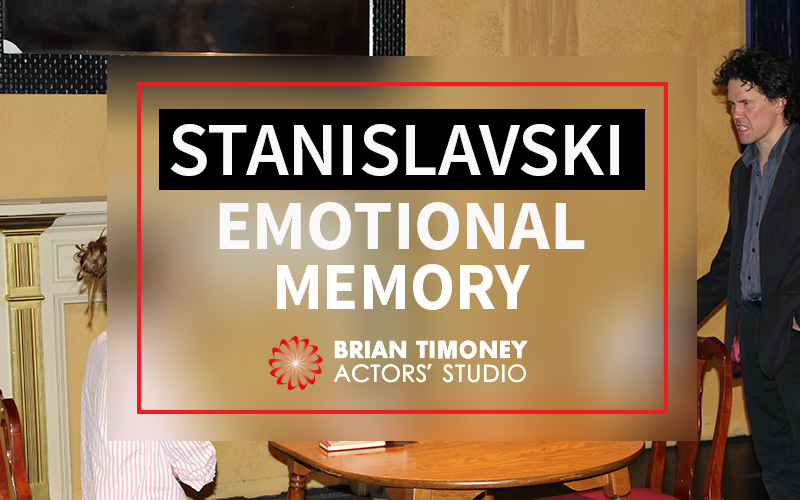“The person you are is a hundred times more interesting than the best actor you could ever become…” – Konstantin Stanislavski
A name recognised even by non-actors, Konstantin Stanislavski and his ‘System’ of method acting is responsible for the success of theatrical heavy-hitters such as Philip Seymour-Hoffman and Daniel Day-Lewis.
However, you don’t need a double barrelled surname to master the dramatic techniques of the system – you only need to have a basic understanding of human emotion. In this way, at least acting jobs are safe from robots.
Method acting asks not that you “act,” but rather that you:
“put life into the imagined circumstances and actions until you have completely satisfied your sense of truth.”
It’s been argued that since the inception of acting, many centuries or even millennia ago, we have recognised that a piece is most effective when the actor truly feels the emotion they’re trying to convey. Aristotle himself swore that:
“the secret to moving the passions in others is to be moved oneself”.
One way of doing this is through emotional memory.
Emotional Memory
Also called Affective Memory, this technique asks us to forget about “acting” out emotions. Feeling emotion is such a visceral part of the human experience that it is at the same time universal and difficult to fake. Because it’s universal, though, you don’t have to fake it – just remember it.
A form of Emotional Memory we have probably all practiced is “crocodile tears”. Think back to when you were a child, trying to make yourself cry to get more pudding, to go home, or to get your sibling in trouble. You probably made these “crocodile tears” by thinking of something sad, like the death of a beloved pet. This is the Stanislavsky system in action.
To summarise: Emotional or Affective Memory asks the actor to call on a memory similar in detail or sensation to their character’s situation. Through empathy, the actor lives the character rather than simply reciting it.
Empathetic Emotional Memory
The aim of Emotional Memory is to feel the emotion your character is going through, but you might not even need a real memory – just an exceptional sense of empathy. Something you saw or read about might evoke your character’s emotion better than the script.
For example; if your character is feeling outraged because someone got a promotion over them, you might not relate. However, you might feel similarly outraged when you remember that since being fired from Top Gear, Jeremy Clarkson has become the highest-paid TV host in Britain.
Although this situation does not directly affect you, it can still cause a deep sense of indignation. This is enough. So long as you feel the emotion of your character – no matter how you get to it – you are enacting the Stanislavsky system.
Sense Memory
Sense Memory, popularised by Lee Strasberg, is a variant of Emotional Memory. This take on the Stanislavski system asks that the actor take time out to recall every detail of their memory. They must remember not just the emotion, but what they heard, tasted, touched, smelled, and saw whilst feeling it.
The effectiveness of recollecting physical sensations in Emotional Memory is still highly debated, but modern Stanislavski academics such as Strasberg suggest it can help actors completely relax into the memory.
Exercises
Sense Memory
Practicing Sense Memory can help ease you into practicing Emotional Memory. To begin with, try to remember an instance of each sense:
See –
Your mother’s face, in as much detail as possible.
The outfit you wore to your first school formal.
A starry sky.
Hear –
Rain against the roof.
Waves on the shore.
Your alarm clock.
Smell –
Smoke from a bonfire.
Freshly baked bread.
Wet dog.
Taste –
Chocolate.
Buttery toast.
Vinegar.
Feel –
A hot mug of tea in your hands.
A cold shower.
A blush spreading across your cheeks.
Emotional Memory
Now that you’ve exercised your Sense Memory, it’s time to practice recalling emotions. Use the senses to ease yourself into Emotional Memory.
We’re going to use the emotion of joy. Try to remember a moment in your life you felt joyful. For example: when you were accepted into university, when your partner first said “I love you,” or maybe just a really good breakfast.
Write it down in detail, using each of the five senses.
Now that you’re experiencing Emotional Memory, practice acting out a short monologue or scene that requires joy. Here’s one from The Perks of Being a Wallflower.
Be Careful
Toward the end of his time, Stanislavski began to doubt the safety of Emotional Memory. The method was exhausting and could have negative side-effects if the actor drew on bad memories without a therapist or counsellor.
There is a danger that you might “go to a dark place,” like Heath Ledger is infamously rumoured to have done. The method asks you not to force a memory, or use one that could hurt you. Stanislavski asks that you don’t “assault the subconscious”. Past memories are preferable to present situations as they’re more controllable .
With that warning in mind – best of luck. Remember the good times and re-live them.


